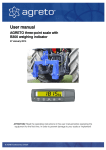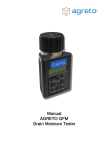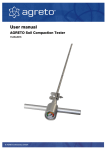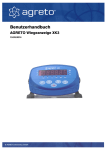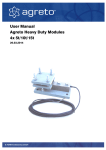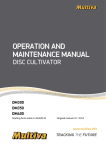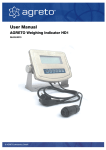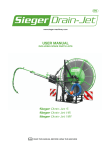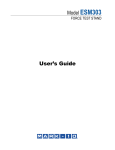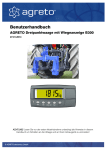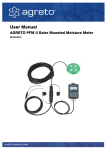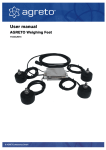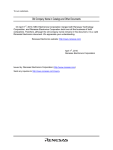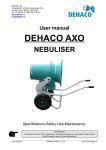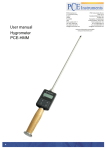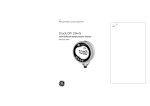Download AGRETO Three-Point-Scale Manual with B400 indicator
Transcript
User manual AGRETO three-point-scale Weighing indicator B400 06 April 2017 ATTENTION! ATTENTION Read the operating instructions in this user manual before operating the equipment for the first time, in order to prevent damage to your scale or implement! © AGRETO electronics GmbH AGRETO three-point scale Table of contents 1 2 3 4 Introduction ........................................................................................................... 3 Scope of delivery .................................................................................................. 3 Intended use ......................................................................................................... 4 Safety .................................................................................................................... 5 4.1 4.2 Safety guidelines for the purchaser ................................................................................ 5 Safety guidelines for operating and assembling personnel ............................................ 5 5 6 Specifications ....................................................................................................... 7 Getting started .................................................................................................... 10 6.1 6.2 6.3 6.4 6.5 6.6 6.7 6.8 Setting lower link distance ............................................................................................ 10 Setting mounting height ................................................................................................ 10 Mounting the three-point scale ..................................................................................... 12 Connecting the weighing indicator ............................................................................... 12 Connecting the distance sensor (if available) ............................................................... 14 Connecting the cable to the signal socket (if available)................................................ 14 Connecting the GPS speed sensor (if available) .......................................................... 15 Connecting the working position sensor (if available) .................................................. 15 7 Weighing indicator .............................................................................................. 16 7.1 Switching on the weighing indicator ............................................................................. 16 7.2 Zeroing .......................................................................................................................... 16 7.3 Standard weighing procedure ...................................................................................... 17 7.4 Weighing with tare function ........................................................................................... 17 7.5 Switching off the weighing indicator ............................................................................. 17 7.6 Settings for displaying the spread rate/ha .................................................................... 18 7.7 Calculating the spread rate ........................................................................................... 20 7.8 General settings ............................................................................................................ 23 7.9 Calibration ..................................................................................................................... 23 7.10 Summing function ..................................................................................................... 25 7.10.1 Setting the summing function .................................................................................... 25 7.10.2 Performing a summation ........................................................................................... 26 7.10.3 Retrieving the sum ..................................................................................................... 26 7.10.4 Deleting the sum ....................................................................................................... 26 7.11 Error messages ......................................................................................................... 27 8 9 10 11 12 13 Troubleshooting .................................................................................................. 28 Maintenance and cleaning ................................................................................. 30 Warranty ............................................................................................................. 30 Declaration of conformity ................................................................................... 31 Disposal .............................................................................................................. 32 Contact information ............................................................................................ 32 © AGRETO electronics GmbH page: page:2 AGRETO three-point scale 1 Introduction Thank you very much for choosing the AGRETO three-point scale. You have just purchased a robust tool for everyday use. The AGRETO three-point scale can only be employed as a checkweigher for internal use. It's not allowed to be used for legal transactions. Please read this manual carefully before putting the scale to use. As in common parlance, the word 'load' is used instead of 'mass' in this user manual. 2 Scope of delivery Standard scope of delivery Steel construction with built-in load cells 2 top link brackets with 160 mm hole spacing 2 top link brackets with 130 mm hole spacing 1 top link and 2 lower link pins with linchpins Weighing indicator with connecting cables This user manual Optional accessories: Lower link hook (instead of ball ends/connection eyes) 3, 5 or 10 m extension cable for the weighing signal Two-line B400 weighing indicator with distance sensor (instead of the standard single-line B300 weighing indicator) Connecting cable to the signal socket for the speed signal (only in combination with the B400 weighing indicator) GPS speed sensor for the speed signal (only in combination with the B400 weighing indicator) © AGRETO electronics GmbH page: page:3 AGRETO three-point scale 3 Intended use The AGRETO three-point scale is a scale for weighing three-point implements and/or their loads. It's mounted at the three-point linkage between tractor and implement. Tractors with Category II and III top links and lower links are suitable, but only Category II implements can be attached. Only implements with a total weight of 6,000 kg can be attached. The scale must be set to the exact same mounting height as the attached implement. The implement can only be connected to the scale via the two lower link pins and the top link pins. No significant push/pull forces must be transferred, which means that soil tillage implements can be attached. Seed drills with normal sowing coulters are acceptable. The weighing procedure can be performed during standstill or whilst driving. Three-point scales aren't officially calibratable and therefore not authorized to determine weights for legal transactions. The scale is meant exclusively as a checkweigher for internal use. © AGRETO electronics GmbH page: page:4 AGRETO three-point scale 4 Safety 4.1 Safety guidelines for the purchaser IMPORTANT! Make sure that every person who works with the AGRETO threepoint scale for the first time, has read and understood this user manual. 4.2 Safety guidelines for operating and assembling personnel Appropriate equipment must be used when employing lifting machinery for transport. Persons who are involved with mounting, removing or setting up the three-point scale, must wear safety shoes. Persons who are involved with mounting, removing or setting up the three-point scale, must wear safety gloves. © AGRETO electronics GmbH page: page:5 AGRETO three-point scale During transport the scale or pallet can slip on the vehicle. Transport and loading personnel must be instructed to securely attach loads. Be aware of the risk of crushing between the three-point scale's moving parts during mounting, removing and setting up. The scale must not be stored or used in a potentially explosive environment. Be careful not to trip over parts or tools that could be lying around you. © AGRETO electronics GmbH page: page:6 AGRETO three-point scale 5 Specifications Scale construction Steel construction with tubes and laser-cut parts Internal load cells Roller supported mounting for implement attachment Designed for implements with a total weight of 6,000 kg Lower link attachment to the tractor: Pins Ø28 mm, 64 mm inner width, for lower link with CAT II ball end, CAT II hook and ball, or CAT III hook and CAT II reduction balls Lower link attachment to the implement: Ball joint Ø28.4mm, 51 mm width or a CAT II Walterscheid quick coupling-hook Lower link distance: CAT II, standard 87.5 cm, can be adjusted infinitely between 85 and 90 cm with set screws, can be adjusted manually up to 105 cm for attachment to a rigid axle Top link attachment to the tractor: Pins Ø25.4 mm, 64 mm inner width, for top links with CAT II ball joint, or CAT II hook and ball Top link attachment to the implement: CAT II mounting brackets Ø26 mm Distance lower link-top link on the attachment: infinitely adjustable between 48 and 68 cm Horizontal distance lower link pins-implement pins (lower link shifted backwards): 160 mm (200 mm for hooks) Horizontal distance top link pins-implement pins (top link shifted backwards): 130 mm or 160 mm depending on the mounting brackets Net weight approx. 80 kg including pins Dimensions: 104x84x20 cm (LxWxH, lying down) © AGRETO electronics GmbH page: page:7 AGRETO three-point scale Load cells 2 high resolution shear force load cells, each at 5,000 kg, 3mV/V, 350 Ohm Total nominal load: 10,000 kg 120% overload, 150% breaking load Protection class IP68 (dust- and waterproof) Operating temperature: -35 up to +65 °C Temperature compensated: -10 up to +40 °C Weighing indicator 6-digit LED-backlit LCD display with 20 mm high digits 12 to 24 Volt power supply Operating temperature: -10 up to +50 °C Real-time clock Tare through the push of a button (zeroing the empty implement) Shockproof and spraywaterproof Stabilized indicator for reading while driving OPTIONAL: Two-line weighing indicator with 30 / 20 mm high digits and special programming to display the spread rate per hectare © AGRETO electronics GmbH page: page:8 AGRETO three-point scale Cabling Internal load cell connection with waterproof box (IP67) 3.5 m long weighing signal cable with special sheathing, from the outlet on the front of the right frame part to the indicator Waterproof, threaded plug connector (IP68) 2 m power supply cable with a flexible universal plug (for cigarette lighter and standard sockets according to DIN EN ISO 4165), with integrated and replaceable fuse Accuracy +/- 0.02% load cell accuracy +/- 1 to 2% accuracy when operated properly in everyday conditions 5 kg weighing indicator resolution Readability during standstill or smooth ride: very good Readability during bumpy ride: sufficient Deviation when load shifts (front, back, left, right): none when operated properly Deviation on slopes: hardly noticeable up to 5% Deviation when inclined sidewards: hardly noticeable up to 5% Deviation when not attached vertically: hardly noticeable up to 5%, can be compensated through calibration © AGRETO electronics GmbH page: page:9 AGRETO three-point scale 6 Getting started 6.1 Setting lower link distance Measure the necessary horizontal distance between both lower link mounting points on your implement (for instance a fertilizer spreader). The standard dimension for Category II is 87 cm, but in practice it's between 86 and 88 cm. Set the required distance on your three-point scale with the adjustment screws. Use the exterior nuts of the adjustment screws on both sides of the three-point scale to keep the construction symmetrical. Set the scale's width in such a way that there's a little space left between scale and implement, so that the scale isn't under tension. When your implement has a rigid mounting axle, you must completely remove the adjustment nuts on one side of the three-point scale, pull the scale apart during mounting and push it back together again. 6.2 Setting mounting height A correct setting of the mounting height is of paramount importance for your scale's accuracy. The horizontal and vertical top link mounting brackets must be in a perfect right angle relative to each other. This will make sure that the load's position doesn't influence weighing accuracy. © AGRETO electronics GmbH page: page:10 AGRETO three-point scale Proceed as follows: Measure the necessary vertical distance on your implement between lower link pins and top link pins. If there are several positions for your top link and/or lower link, choose a combination where the distance is between 50 and 65 cm. Determine which of the 4 holes on the three-point scale's vertical top link brackets must be used for the distance you measured. Loosen the 4 interior nuts of the adjustment screws, set the measured distance, and tighten the nuts again. The distance can still be readjusted after the implement is attached, but first relieve any load from the scale. Slightly loosen the nuts and use a rubber hammer to shift the brackets. ATTENTION: The exact setting of mounting height is not only a prerequisite for accurate weighings. When the angle is not exactly right, the threethree-point scale and/or your implement could get damaged or deformed. © AGRETO electronics GmbH page: page:11 AGRETO three-point scale 6.3 Mounting the three-point scale You can choose whether you first want to mount the three-point scale to the tractor or the implement. When your implement has a rigid axle, you must first mount the scale to the implement. Of course, the scale can be left mounted on the implement if it is only used for that implement. Try to use the three-point scale in a position that is as vertical as possible. Either use the brackets with 130 mm hole spacing, or the brackets with 160 mm hole spacing. If vertical mounting isn't possible, the scale must be calibrated to obtain correct results. Deviations are hardly noticeable when under 5 degrees in comparison to the vertical position. 6.4 Connecting the weighing indicator Position the weighing indicator in a suitable spot in the vehicle. Connect the power supply cable. Either use the provided cable or connect the indicator directly to the electric system. The indicator can be run on a voltage between 12 and 24 Volt. If during operation the power supply to the indicator is interrupted, it will remember the scale's zero point, but not a tare point that might have been set. Connect the weighing signal cable to the plug on the three-point scale. You could run the cable along the hydraulic tubes to prevent damage. © AGRETO electronics GmbH page: page:12 AGRETO three-point scale The weighing signal cable is assigned as follows: Front view cable socket on the scale Number Description Front view cable plug on the connecting cable Function 1 EX - Supply - 2 EX + Supply + 3 SI - Signal - 4 SI + Signal + 5 6 7 © AGRETO electronics GmbH page: page:13 AGRETO three-point scale 6.5 Connecting the distance sensor (if available) In this variant driving speed is determined by a distance sensor. The sensor has a blue cap and the cables are marked blue near the plug connectors. Mount the 4 magnets to the rim of a wheel (or on the front axle for tractors with rear wheel drive) using the included screws. Make sure the magnets are evenly distributed. Mount the blue capped sensor with a flat bar in such a way that the sensor tip points towards the magnets. Set the distance between sensor and magnets at 5 mm. As soon as the sensor is correctly installed and connected, the weighing indicator will display the driving speed in 10 second intervals. To check the driving speed the working position sensor must be in the working position (=valve open) or unplugged. The amount of impulses per 100 m is set in the weighing indicator. 6.6 Connecting the cable to the signal socket (if available) In this variant driving speed is determined via a connecting cable to a signal socket. The connecting cable with 4-pole plug is connected to the cable that is marked blue. The other side is connected to the signal socket. The weighing indicator displays the driving speed in 10 second intervals. To check the driving speed the working position sensor must be in the working position (=valve open) or unplugged. The amount of impulses per 100 m is set in the weighing indicator. © AGRETO electronics GmbH page: page:14 AGRETO three-point scale 6.7 Connecting the GPS speed sensor (if available) In this variant driving speed is determined via a gps receiver. The receiver is positioned on the roof and the 4-pin plug is connected to the cable that is marked blue. The weighing indicator displays the driving speed in 10 second intervals. To check the driving speed the working position sensor must be in the working position (=valve open) or unplugged. The amount of impulses per 100 m is set in the weighing indicator. 6.8 Connecting the working position sensor (if available) The sensor has a red cap and the cables are marked red near the plug connectors. The working position sensor tells the weighing indicator whether there is any output. That way the weighing indicator takes into account that some stretches are driven in the headland, or that the valves are closed, and stops calculating total completed area. Mount the working position sensor near the valve or your implement's volume adjuster. The sensor must be mounted in such a way that it is positioned in front of the magnet when closed. The magnet should move away from the sensor when opened. When there are separate adjustment mechanisms for the left and right side, mount the sensor and magnet on the side that opens when spread width is halved. © AGRETO electronics GmbH page: page:15 AGRETO three-point scale 7 Weighing indicator 7.1 Switching on the weighing indicator Switch the weighing indicator on with the small button on the far left. The indicator shows a start-up sequence, followed by the scale's actual load, based on the most recently set zero point. The upper, larger line displays the scale's actual load (for instance 865 kg) and the lower, smaller line displays the spread rate per hectare (for instance 220 kg). Next to that, small digits display the driving speed (for instance 10.8 km/h). 7.2 Zeroing The [ZERO] button resets the indicator's zero point. Use this function for zeroing the scale with an attached and raised implement. This puts the zero point on the implement's empty weight, after which a load's weight can be read directly. © AGRETO electronics GmbH page: page:16 AGRETO three-point scale 7.3 Standard weighing procedure Load and unload the implement, or use your implement as usual, and the load's actual weight will be displayed immediately on the weighing indicator. The indicator is stabilized, which allows you to read the weight while driving. 7.4 Weighing with tare function The tare-function can be used to determine the amount of material which is scattered to a part of a field: Press the [TARE] button at the beginning. The indicator shows 0 and displays the NET symbol. Continue with your work, on the display you see the net-weight. This is the lost weight since the activation of the tare function. If you want to see the total weight, you can use the [SELECT] key to toggle between the total weight and the net weight. Read the net weight at the end of your partial area and return to the total weight display with the [SELECT] key. You can repeat this process as often as you like. 7.5 Switching off the weighing indicator Keep the button on the far left pressed until the weighing indicator switches off. © AGRETO electronics GmbH page: page:17 AGRETO three-point scale 7.6 Settings for displaying the spread rate/ha The following parameters are responsible for the weighing indicator's functionality with regards to the spread rate: SPREAD PULSES 10 Impulse/100m SPREAD WIDTH 10 Spread width in m SPREAD UPDATE 10 Interval in seconds SPREAD RES 10 Resolution SPREAD INPUT IO1 Sensor input SPREAD MIN.DSP 50 Indicator minimum quantity SPREAD PREC COUNTS Calculation method The first first two parameters have to be set by you. The other parameters have been pre-set in such a way that normal operation is possible right away. Proceed as follows to change other relevant settings: Simultaneously keep the lower buttons on the far right (F3) and far left (the small one) pressed for 3 seconds. Wait until the word GEN.OPT appears on the display. Press the [ZERO] button several times, until SPREAD appears on the display. Press the [TARE] button. PULSES appears on the display. Determine how many impulses the sensor sends per 100 m driven. Either drive exactly 100 m, count the amount of revolutions and multiply that with the amount of mounted magnets. Or measure the wheel circumference and manually calculate the amount. When you use the adapter cable to the signal socket, you normally have to enter 406 impulses. According to standard the signal socket sends 13,000 impulses per 100 meter. The electronics in the adapter cable reduces this by 1/32. In practice many signal sockets do not provide the signal according to standard, with values varying between 200 and 450. It's best you enter 400 and synchronize the displayed driving speed with the tractor's speedometer. © AGRETO electronics GmbH page: page:18 AGRETO three-point scale To set the amount of impulses you enter the number with the numeric keypad and confirm by pressing the [OK] button. By pressing the [TARE] button the next parameter WIDTH appears. Enter the working width in m with the numeric keypad and confirm by pressing the [OK] button. Press the [ZERO] button until it says END on the display. By pressing the [TARE] button the settings are stored, and the indicator restarts. © AGRETO electronics GmbH page: page:19 AGRETO three-point scale 7.7 Calculating the spread rate The quantity applied per hectare can be calculated in two different ways: Automatic Mode Automatic mode is already active when the weighing indicator is switched on. The „A“ symbol appears in the top right of the display. Press the [F3] button to switch from manual mode to automatic mode. In automatic mode the weighing indicator calculates average weights for consecutive intervals. An interval normally lasts 10 seconds and can be adjusted through the SPREAD_UPDATE parameter (not recommended). At the end of every interval the difference in weight between the interval's average weight and the preceding interval's average weight is calculated. This difference is then set off against the completed area (distance driven x working width) per interval, and is displayed as kg/ha. Because automatic mode is always running, you can continuously check the quantity applied per hectare and the driving speed, without having to operate the indicator. The quantity applied in kg/ha is only displayed if it exceeds the value in the SPREAD_MIN.DSP setting. When you start applying, the indicator is in the middle of an interval. Because of this the first interval isn't complete and thus useless for calculating the spread rate. If you press the [F3] button on the weighing indicator, it will immediately start a new interval. It is therefore recommended to press the [F3] button as soon as you start the application process, and have already reached the desired driving speed. © AGRETO electronics GmbH page: page:20 AGRETO three-point scale Please observe the following when reading the spread rate: When you start driving, you have to drive three intervals with a constant driving speed (standard setting is 30 seconds) before an accurate weight has been calculated. That's because the first interval isn't complete. Unless the calculation was initiated with the [F3] button. When spread rates per interval are low, weight fluctuations that necessarily occur during driving significantly affect the calculated quantity. The displayed value per hectare will fluctuate a lot, which means you will have to calculate the average of the displayed values and base decisions on that. In case of highly fluctuating, meaningless values you should switch to manual mode. When the indicator is displaying the quantity applied per hectare while driving on roads, this is caused by weight fluctuations and can be ignored. Manual mode In manual mode you can determine the start and end of calculation intervals yourself. This allows calculations during a longer period, for instance an entire field length. With an installed working position sensor, this calculation can even be extended to cover several field lengths up to an entire field. Manual mode is started by pressing the [F1] button. The „M“ symbol appears in the top right of the display. A calculation cycle starts and the scale's actual weight is stored as the calculation's initial weight. The calculated result is updated in the pre-set interval. An interval normally lasts for 10 seconds and can be altered through the SPREAD_UPDATE parameter (not recommended). The scale's actual weight will then be taken as final weight and the spread rate per hectare will be shown from the first to the actual interval. Pressing the [F2] button starts the calculation at any given time, and displays the result. While the calculation continues in the background, the intermediate result is displayed. The [F2] button can be pressed as often as desired. Every time the updated quantity will be displayed. You can press the [F1] button to start, and the [F2] button to read the result while driving. © AGRETO electronics GmbH page: page:21 AGRETO three-point scale Also observe the following when working in manual mode: If you haven't installed a working position sensor, the calculation must be stopped by pressing the [F2] button when the end of a track has been reached, or else the U-turn is also recorded and distorts the result. For the same reason a new cycle must be started at each new track by pressing the [F1] button. Maintain a constant speed during the entire calculation period, with the same settings, to obtain a correct result. When the driving speed or settings change, a new cycle has to be started to obtain meaningful average results. Pressing the [F3] button ends manual mode and the indicator switches back to automatic mode. © AGRETO electronics GmbH page: page:22 AGRETO three-point scale 7.8 General settings The weighing indicator contains several adjustable parameters that influence the system's functioning. Normally these parameters have been pre-set correctly and only need to be changed in the case of specific requirements. For use with the AGRETO three-point scale, the weighing indicator's following parameters differ from default settings: SCALE BUILD TYPE DUAL.R (set measurement method) SCALE BUILD CABLE 4 (load cell connection with 4 cables) SCALE BUILD CAP1 6000 (maximum load) SCALE BUILD E1 5 (resolution) SCALE BUILD CAP2 6000 (maximum load) SCALE BUILD E2 5 (resolution) SCALE OPTION FILTER 10 (indicator attenuation) SCALE OPTION Z.RANGE –20 +20 (zeroing up to 20% of maximum load) SCALE CAL SPAN 2667 (calibration value at 0.8 mV) 7.9 Calibration When the AGRETO three-point scale is operated vertically or with a slight slant forward or backward, the factory-set calibration is correct and the scale is ready for direct use. If this isn't possible, the weighing indicator must be calibrated, depending on how the scale is employed. A calibration determines the scale's accuracy. Perform the following steps only when necessary and with the greatest care. Every new calibration replaces the previous calibration, and can be repeated as often as desired. Use this method only when you have a load of which you know the exact weight. It is also important that this load can be placed in the middle of the implement. Instead of a load, a charge of fertilizer can also be filled during the calibration process. The weight of this charge must be known, however, or the tractor and implement must stand on a scale (weighbridge) during the calibration process. © AGRETO electronics GmbH page: page:23 AGRETO three-point scale Proceed in the following manner: Place your vehicle on an even surface. Put the empty implement in the operating position. Keep the weighing indicator's buttons on the far right (F3) and left (small button) pressed simultaneously, until the calibration sequence starts. Wait until the word GEN.OPT appears on the display. Press the [ZERO] button twice. SCALE appears on the display. Press the [TARE] button 3x. CAL appears on the display. Press the [GROSS/NET] button. ZERO appears on the display. Press the [OK] button twice. “Z in P” appears on the lower line. The zero point is now defined. Wait until it says “Done” on the lower line. Press the [OK] button. ZERO appears on the display. Press the [GROSS/NET] button. SPAN appears on the display. Press the [OK] button twice. Now put a load on the scale of which you know the weight, or fill your implement with a known amount of material. The weight should be as large as possible, completely filling your implement would be best. To prevent tensions in the implement and scale from influencing the calibration, drive forwards and backwards again. Change the displayed number to the actual weight of the load that was filled in, by entering it with the numeric keypad. Press the [OK] button. S.inP appears on the display. The calibration will now be executed. Wait until it says „Done“ on the lower line. Press the [OK] button. SPAN appears on the display. Press the [ZERO] button until it says END on the display. Press the [TARE] button, the settings are stored, the indicator restarts. © AGRETO electronics GmbH page: page:24 AGRETO three-point scale 7.10 Summing function In the three-point scale's software all three programmable function keys have already been allocated. Because Automatic Mode, which can be started with the [F3] button, is used very rarely in practice, and is already active as soon as the indicator is switched on, the [F3] button could also be used for a summation. 7.10.1 Setting the summing function Keep the weighing indicator's buttons on the far right (F3) and left pressed simultaneously, until the setup mode starts. Press the [TARE] button 6x. DISP appears on the display. Press the [GROSS/NET] button 3x. AUX.DSP appears on the display. Press the small arrow up key on the right of the indicator, until NUM.ITEMS appears on the lower line. This sets up the indicator in such a way that all sums appear on the display. Press the [OK] button on the numeric keypad. Press the [ZERO] button 4x. FUNC appears on the display. Press the [TARE] 4x. SF3 appears on the display. Press the [GROSS/NET] button. TYPE appears on the display, with STOP on the second line. Press the small arrow up key on the numeric keypad until it says PRINT on the display's second line. Press the [OK] button on the numeric keypad. Press the [GROSS/NET] button twice. TOTAL appears on the display, with NONE on the second line. Press the small arrow up key on the numeric keypad until it says ADD on the display's second line. This sets up the indicator in such a way that the [F3] button activates the summing function. Press the [OK] button on the numeric keypad. Press the [ZERO] button until END appears on the display. Press the [TARE] button, the settings are stored, the indicator restarts. © AGRETO electronics GmbH page: page:25 AGRETO three-point scale 7.10.2 Performing a summation The [F3] button can be pressed at any time to add up weight values. The weight that is shown in the first line is stored in the summation memory. Make sure that the weight value doesn't fluctuate during summation. In the upper right corners the amount of values in the summation memory are displayed. As soon as this amount increases, the summing function has been performed. 7.10.3 Retrieving the sum To display the sum, keep the [4] key (secondary function: total) pressed for approx. 2 seconds. TOTALS appears on the display, and on the second line the sum of stored weights. Press the [OK] button to return to normal display mode. 7.10.4 Deleting the sum To delete the sum it must first be displayed (see above), after which you hold the arrow down key (secondary function: del) pressed for approx. 2 seconds. ALL.TOT and “Clear?” Appear on the display. Confirm by pressing the [OK] button. The summation memory is now cleared. Press the [OK] button to return to normal display mode. © AGRETO electronics GmbH page: page:26 AGRETO three-point scale 7.11 Error messages Error Description Action U.LOAD Underload Increase load or switch the scale off and back on again O.LOAD Overload Reduce load ERROR RANGE Zeroing attempt outside of the permitted range Reduce load ERROR MOTION A [ZERO] or [TARE] command can't be executed because the scale is unstable Try again when the scale is stable FAILED TOO CLOSE The difference between zero point and calibration weight is too small Use a higher calibration weight E0200 Calibration is lost Make a new calibration E0400 All settings are lost Make all settings and the calibration again E2000 Scale is not connected Turn off the indicator Connect the scale Turn on the indicator E2000 Weighing signal out of range Check cable and plugs for damage © AGRETO electronics GmbH page: page:27 AGRETO three-point scale 8 Troubleshooting Proceed as follows when you have reason to believe the displayed weights are incorrect: Make sure that there is no transfer of forces because a part of your implement touches the scale. The implement can only be in contact with the scale through 3 attachment pins. Make sure that the scale isn't attached too tightly on the side to your implement. Check if there is still some space on both sides of the lower attachment points. Consult chapter 6 of this manual. Check whether the angle between scale and mounting brackets is exactly right. The factory-set calibration is only correct under an exact right angle, and the position of the load doesn't influence the weighing result. Consult chapter 6 of this manual. Try to use the scale in a position that is as vertical as possible. Use the top link brackets with either 130 mm or 160 mm hole spacing. If this isn't possible, the weighing indicator must be calibrated for the application. A small deviation of a few degrees doesn't matter that much. Calibrate the scale. Follow the instructions in this manual (chapter 7.10). Unsatisfactory weighing results can be caused by tensions in the scale's suspension. The 3 attachment pins aren't supported by ball bearings, and even when balls and/or hooks are used, tensions build up in the system due to load changes. These tensions dissipate while driving or moving. This is the reason why the scale and implement must be moved twice during the calibration process. It also explains why the scale weighs more accurately during movement than during standstill. During static weighings (for instance: slowly filling a fertilizer spreader) the displayed weight is usually lower than the true weight of the load, because of tensions in the system. Under higher loads the scale might not react smoothly to changes in weight. When you have enough experience with your system, you can add the missing weight. If not, you have to stop filling a bit earlier and clear the tensions in the system by moving, after which the correct weight will be displayed. Check without attached implement whether the scale displays the same weight on both sides. Stand on the left and then the right side of the linkage. If the difference is larger than 5 kg, one of the load cells is malfunctioning or load cell © AGRETO electronics GmbH page: page:28 AGRETO three-point scale suspension needs to be readjusted. If this is the case, please contact the manufacturer. Check with implement attached whether the scale shows the same weight when the load is in the front and then in the back of the implement. If this isn't the case, the imbalance must be offset by changing the angle of the top link mounting brackets: If the scale displays a higher weight in the back, you must shift the two mounting parts slightly upwards. You do not have to remove the scale. Loosen the 4 internal nuts of the mounting screws and tap the bottom of the sliding mounting parts with a rubber hammer. If you can't slide them any further, you have to remove the scale and insert the upper link pin in the next hole. If the scale displays a higher weight in the front, you must shift the two mounting parts slightly downwards. You do not have to remove the scale. Loosen the 4 internal nuts of the mounting screws and tap the top of the sliding mounting parts with a rubber hammer. If you can't slide them any further, you have to remove the scale and insert the upper link pin in the next hole. © AGRETO electronics GmbH page: page:29 AGRETO three-point scale 9 Maintenance and cleaning Clean the AGRETO three-point scale together with your implement. Highpressure cleaning must be done from a distance of at least 0.5 m. Store the machine in a dry and safe place. When you don't use the machine for a longer period, treat it with a suitable anticorrosive agent. 10 Warranty In addition to the legally required warranty, the following warranty conditions apply to the AGRETO three-point scale: AGRETO electronics GmbH guarantees proper functioning, and repairs or replaces all parts that exhibit material or manufacturing defects during the warranty period. Warranty services are provided by AGRETO electronics GmbH only. The decision whether warranty applies, is made exclusively by AGRETO electronics GmbH. The warranty period starts when the end user is billed and ends 5 years after the invoice date. A requirement for warranty is the presentation of the original invoice and compliance with all the points in this user manual. Warranty doesn't apply to wear and tear, nor to damages due to improper use, negligence or accidents. In case of a warranty claim transport costs are to be paid by the purchaser. © AGRETO electronics GmbH page: page:30 AGRETO three-point scale 11 Declaration of conformity EC declaration of conformity For the following product: AGRETO three-point scale This confirms that the product meets the essential safety requirements, as stipulated in the Council Directive on the approximation of the laws of the Member States relating to electromagnetic compatibility (2004/108/EG). The evaluation of this product was carried out in accordance with the following standards: EN 55022:1998 EN 60601-1-2:2007 ÖNORM ISO 2332 This declaration is made for and on behalf of the manufacturer AGRETO electronics GmbH Pommersdorf 11 3820 Raabs Submitted by: Anton Eder Managing director Pommersdorf ___________________ 27.01.2014 ________________ ______________________ legally binding signature © AGRETO electronics GmbH page: page:31 AGRETO three-point scale 12 Disposal When the product has reached end-of-life, dispose of the product or parts thereof in an environmentally responsible manner, with materials separated according to type (scrap metal, plastic waste, etc. - do not add to household waste)! Detailed information can be found in Directive 2002/96/EG 13 Contact information All information, specifications and images in this manual are correct according to the status in 2017, and subject to technical adjustments or changes in design. Despite careful treatment and examination of the contents, no warranty is made with respect to information in this user manual. Any liability of the author is excluded. Copyright © 2017, AGRETO electronics GmbH AGRETO electronics GmbH Pommersdorf 11 A-3820 Raabs Tel.: +43 2846 620 0 Fax: +43 2846 620 19 E-Mail: office@agreto.com Internet: www.agreto.com © AGRETO electronics GmbH page: page:32




































